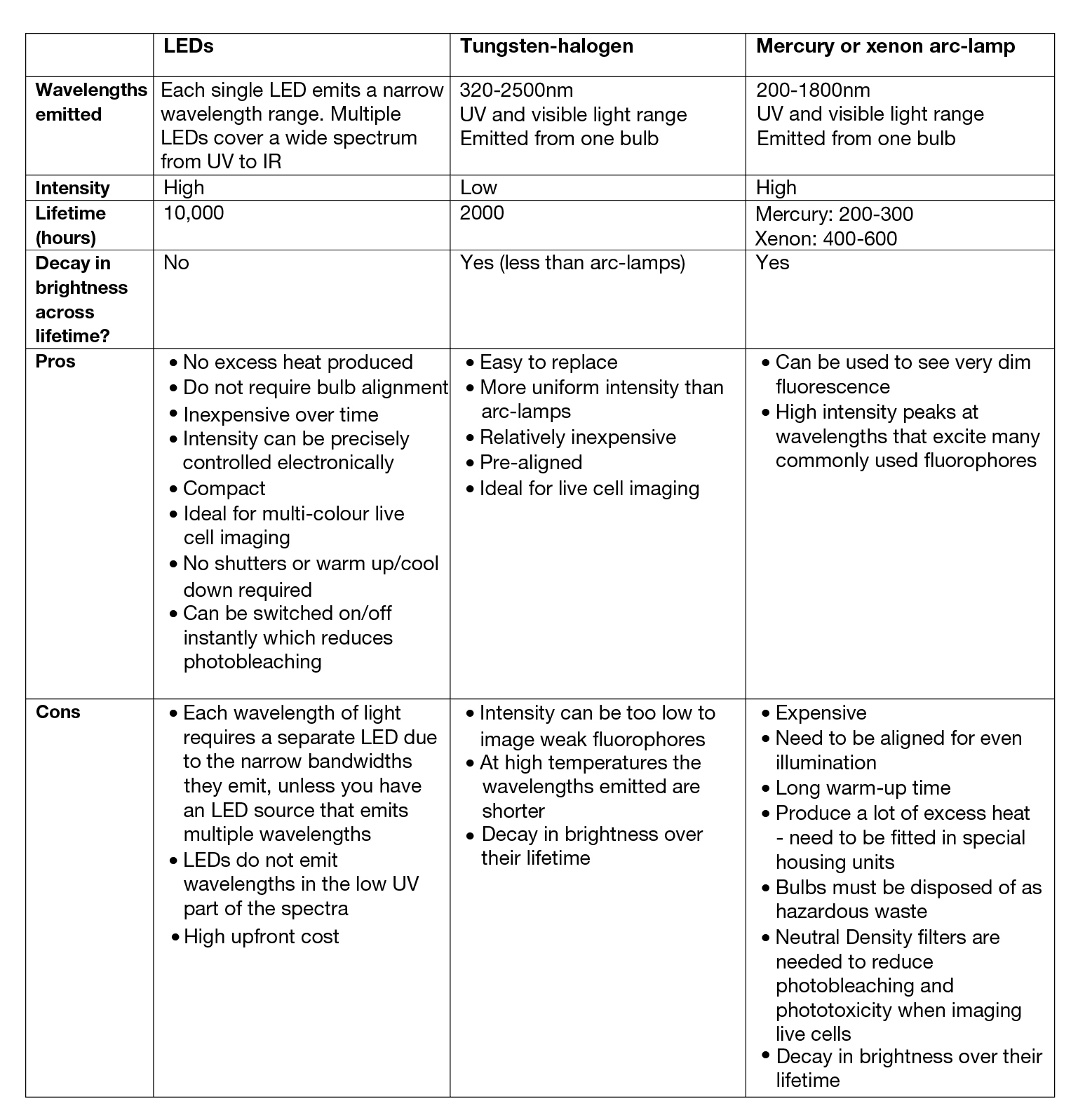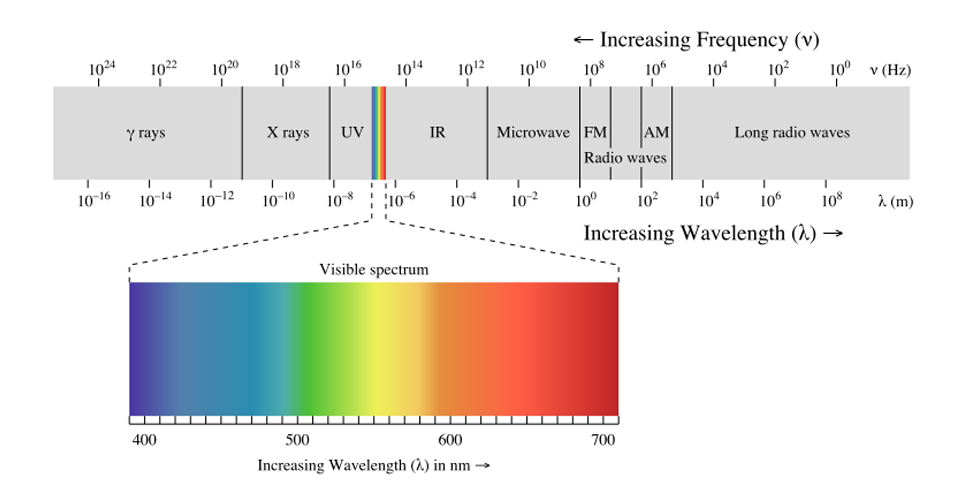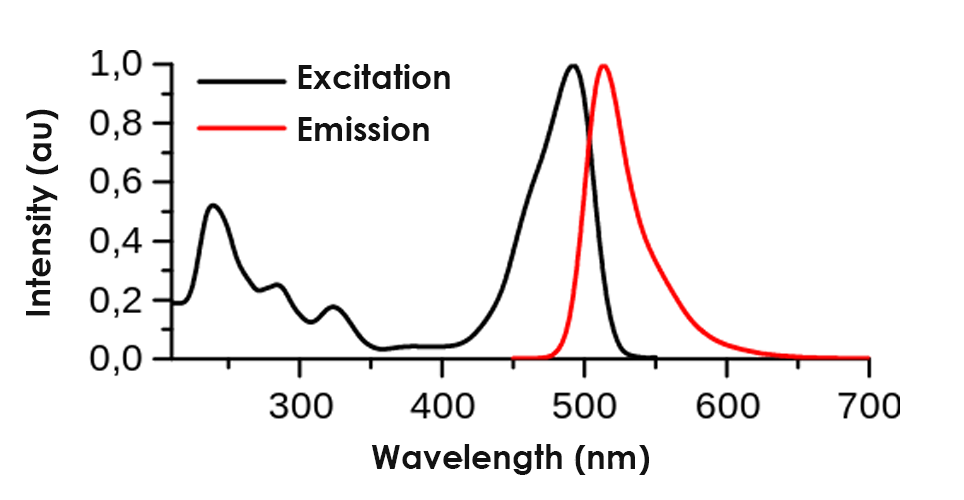
Choosing the best light source for your fluorescence experiment
A variety of light sources can be used to illuminate a sample during widefield fluorescence microscopy experiments. Choosing the best light source for your microscopy experiment requires evaluating their properties and balancing out their pros and cons.
Here, we introduce the three commonly used fluorescent light sources and discuss their properties as well as their advantages and limitations, to help you make an informed decision of which source is best suited to your experiment.
When choosing the best fluorescence light source for your research, there are many factors to consider, including:
- Power/Intensity
- Spectrum
- Coupling to the microscope
- Control from third-party software
- Overall lifetime
- Stability over time
- Cost to buy
- Maintenance cost
- Power consumption
- Footprint and recycling
Fluorescent light sources
Commonly used light sources in widefield fluorescence microscopy are light-emitting diodes (LEDs), mercury or xenon arc-lamps or tungsten-halogen lamps. The most common light sources used today are light-emitting diodes (LEDs); their properties mean they are usually superior in comparison to arc-lamps and tungsten-halogen lamps, which were more commonly used in the past.
This table gives an overview of the properties of these light sources:

Light intensity and spectrum
The light source used in a fluorescence microscopy experiment must emit the specific wavelengths of light that excite the fluorophores present in the sample. This light must be emitted at a high enough intensity to stimulate as much fluorescence emission as possible. For more information about how this technique works, read our widefield fluorescence microscopy overview.
Often, white light sources are used, as white light contains all the wavelengths of light in the visible spectrum at equal intensities. This means specific wavelengths within this range can be selected using excitation filters.

Excitation filters select the specific wavelength required, but, as these do not suppress all the peripheral light, the light source should have a high intensity in the fluorophore's excitation spectra. This prevents unwanted excitation of other fluorophores in the sample as well as light damage to the sample.
The intensity of light required can depend on the sample that you are imaging. When imaging live cells, lower intensities of excitation light are best to avoid damaging the cell through photobleaching and phototoxicity. Whereas, for illumination of larger fields of view or when high speed is needed to visualise changes in the sample, light sources of a higher intensity are required.
Arc-lamps
Mercury and xenon arc-lamps are white light sources that produce a wide range of wavelengths from ultraviolet (UV) to infrared (IR). They have many intense bands at wavelengths across the UV and visible light spectrum and emit bright UV light. As they cover the whole visible spectrum, if a new dye is being used, a filter cube can filter a new wavelength of excitation light using the same lamp.
However, arc-lamps do not provide even illumination intensity across the visible light spectrum; the main peaks are in the near-UV wavelengths, with two other peaks in the green/yellow part of the spectrum. The peaks are at wavelengths of 313, 334, 365, 405, 436, 546 and 579nm, leaving gaps in regions that excite many important fluorophores, such as Fluorescein and Fluo-4.

Xenon arc-lamps have a more consistent intensity across the entire spectrum compared to mercury. This intensity is higher in the IR range, meaning a lot of excess heat is produced, which can harm live samples.
As arc-lamps emit high-intensity light, fixed samples may suffer from photobleaching if neutral density filters are not used to reduce the intensity of the light, or if the exposure time is not decreased.
Unlike LEDs, the intensity of light cannot be precisely controlled in arc or tungsten-halogen lamps. This is because intensity is controlled using either neutral density filters or iris diaphragms. These have limited intensity control as they enable a few discrete bands of intensity rather than allowing intensity to be modified in smaller increments.
Tungsten-halogen lamps
The spectrum of tungsten-halogen lamps is similar to arc-lamps, with lower peak intensities and more even illumination across the field of view. Tungsten-halogen lamps are pre-aligned, saving time and effort.
When a single microscope will be used for different experiments, light sources that can emit a large range of wavelengths are most suitable. Tungsten-halogen lights are best for these applications as they can provide wavelengths across the visible light range at a high enough power to excite fluorophores. However, these lamps have weak emission in the UV part of the spectrum, and so arc-lamps are more suitable for imaging samples that require wavelengths below 400nm.
Tungsten-halogen lamps emit a lot of excess heat. This can cause the specimen to degrade faster, so a heat-blocking filter is needed to prevent this.
LEDs
LEDs are solid-state semiconductor devices that emit light directly without using a bulb. LEDs can emit light across the visible light range with discrete, narrow excitation peaks. The intensity of LEDs can be precisely controlled in 1% increments. Intensity can be greater than mercury lamps in blue and red excitation regions but is weaker than mercury lamps in the green excitation region. LEDs emit lower intensity light at wavelengths in the UV part of the spectra. The lowest wavelength of light emitted is 340nm, therefore some UV dyes cannot be excited by LEDs.
LEDs enable fast switching between wavelengths, meaning multiple fluorophores can be excited within the same sample during one experiment. They are particularly suited to fast multi-colour imaging.
Lifetime and stability of light sources
Arc-lamps
Arc-lamps have an average lifetime of just 500 hours, decay in brightness with time and cannot be switched on and off quickly as this reduces their lifetime. As they require time to warm up before they reach their peak intensity, arc-lamps are usually turned on for longer periods of time, which further reduces the number of hours they are used to image samples.
Tungsten-halogen lamps
Tungsten-halogen lamps have a lifetime of 2000 hours and decay in brightness with time, but much less so than arc-lamps, making them a more cost-effective light source compared to arc-lamps.
LEDs
LED light sources have by far the longest lifetime and their brightness does not decrease with time. The long lifetime and stability of LEDs mean they are excellent for experiments running across many days or weeks. LEDs are suited to automated experiments, as all images can be taken under the same excitation conditions from the start to the end. They do not require any time to warm up or cool down, so can be used as soon as they are switched on. This also reduces the time that LEDs are switched on for, therefore extending their lifetime.
Light source costs: Purchase and maintenance
Arc-lamps
Arc-lamps are inexpensive to buy. However, because the bulbs have a short lifetime, this light source needs to be disposed of as hazardous waste and be aligned every time it is changed to ensure even illumination. This means they are not an economical option.
Tungsten-halogen lamps
Tungsten-halogen bulbs are also relatively cheap to buy. Although they last more than four times longer than arc-lamps, bulbs are still likely to be needed to be replaced multiple times within the lifespan of an LED. The excess heat emitted from a tungsten-halogen lamp can cause parts of the microscope to have a shorter lifespan; replacing these parts adds more to the cost of the lamps.
LEDs
LEDs have the highest upfront cost. However, they are often more economical due to their low maintenance costs, long lifetime and stability. Maintenance costs are reduced as they do not need to be aligned or disposed of as hazardous waste. LEDs are more energy efficient than other light sources, saving money on electricity.
As LEDs do not require time to warm-up, they do not need to be left on all day to overcome warm-up time, but can be switched on and off instantly. This also means that shutters are not needed, enabling additional savings to be made and preventing vibrations from shutters that may interfere with electrophysiology experiments.
Compatibility with the microscope
The most convenient way to couple a light source to a microscope is to mount it directly onto the microscope. However, in the case of arc and tungsten-halogen lamps, this can bring heat and vibration (due to cooling fans) to the microscope. This can damage the sample and disrupt the images produced. To reduce this interference, light sources that are mounted on the microscope are often less powerful to reduce the heat and vibrations produced.
Therefore, it is usually preferable to fit systems with liquid light-guides that deliver the light to the microscope when the source is remote. Liquid light-guides are transmitters of high-intensity light. They can be made from a variety of core materials that are able to transmit UV, visible and IR light. Using a liquid light-guide reduces the electrical noise and vibrations at the microscopes. They do also reduce the power of the light, due to coupling losses, but this is often not a problem due to the high intensity of the light.
Arc-lamps
Arc-lamps can be located in arc-discharge lamphouses on the microscope. As arc-lamps need to be aligned to evenly illuminate the sample, the lamp socket requires lamp centring screws that enable the image to be centred in the objective lens. The lamphouse also requires an IR filter to block wavelengths in the IR range, and thus heat.
The lamphouse needs to have a switch that automatically turns off the arc-lamp if the house is accidentally opened while the lamp is on. It should also be unable to leak UV wavelengths, which can be harmful, and be able to endure the arc-lamp burner exploding.
Delivering light from arc-lamps via a liquid light-guide ensures even illumination across the field of view, as well as reducing the heat and vibrations at the microscope.
Tungsten-halogen lamps
Tungsten-halogen lamps are also often contained in a lamphouse. The lamphouse is coupled to the microscope via a proprietary mounting flange. An IR filter in front of the collector lens absorbs a large amount of unwanted IR wavelengths and heat. Additional filters can typically be inserted into the light path to select specific wavelength bands or neutral density filters can be inserted, reducing the amplitude of the light.
LEDs
LED light sources are typically controlled by a remote pod that sits beside the microscope. This allows the researcher to switch the wavelength on multi-wavelength systems and adjust the intensity at the same time as looking at the sample.
Alternatively, LEDs can be integrated into the microscope or imaging software package. This enables automation and the benefit of the fast-switching capability is greater.
For multicolour imaging systems, the LEDs are in a ‘light engine’ and are usually coupled to the microscope via a liquid light-guide.
Safety
It is important to never look directly at a light source that is switched on and not coupled to a microscope. When testing the light source, point it at a non-reflective surface to avoid damaging your eyes.
Arc-lamps
Arc-lamps generate high levels of UV light, which can damage the human eye. Therefore, they require a UV filter to reduce the risk of injury.
When using mercury arc-lamps, care should be taken to ensure the lamps are replaced when they reach the end of their recommended lifetime. This is to help reduce the risk of the bulb exploding and releasing mercury vapour into the air, which is toxic.
There are also strict requirements for mercury bulbs to be disposed of as hazardous waste. This can be both time-consuming and costly.
Tungsten-halogen
Tungsten-halogen lamps also emit UV light. Looking directly at UV light for extended periods of time can lead to long-term damage. For experiments that involve lengthy sessions viewing the specimen, a heat/UV filter will be required.
LEDs
As LEDs emit light outside the UV spectrum, these are much safer than arc and tungsten-halogen lamps as the emitted light will not cause discomfort or damage to eyes. LEDs also carry no risk of releasing toxic chemicals, making these the safest light source.
If you would like further advice or guidance, please do not hesitate to contact the team at Scientifica.
Scientifica SliceScope
A stable and compact upright microscope, versatile for a variety of techniques, including fluorescence microscopy, electrophysiology, multiphoton imaging. Upgradeable as your experiments develop, you can start with a slimline SliceScope frame, then add additional functionalities when required, such as multiphoton scan heads, manipulators and the HoloStim-3D Spatial Light Modulator.


)